
Lakewood is a town in Oconto County, Wisconsin, United States. As of the 2000 census, the town population was 875. The census-designated place of Lakewood is located in the town.
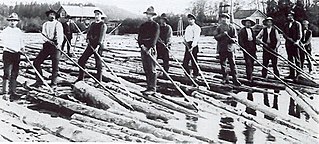
Log driving is a means of moving logs from a forest to sawmills and pulp mills downstream using the current of a river. It was the main transportation method of the early logging industry in Europe and North America.
Lost Channel is a ghost town in Parry Sound District, Ontario.

The Chippewa River in Wisconsin flows approximately 183 miles (294 km) through west-central and northwestern Wisconsin. It was once navigable for approximately 50 miles (80 km) of its length, from the Mississippi River, by Durand, northeast to Eau Claire. Its catchment defines a portion of the northern boundary of the Driftless Area. The river is easily accessible for bikers and pleasure seekers via the Chippewa River State Trail which follows the river from Eau Claire to Durand.

Michigan logging wheels are a type of skidder that was introduced in the nineteenth century United States logging industry as a state-of-the-art technology for transporting lumber and timber over rough terrain. They proved most valuable in the winter months as they could extend the logging season since they were not dependent upon good seasonal weather conditions. It enabled a set of domestic labor animals to be able to transport many heavy logs of various sizes over a long distance of uneven wet ground.
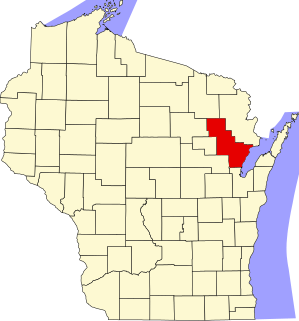
This is a list of the National Register of Historic Places listings in Oconto County, Wisconsin. It is intended to provide a comprehensive listing of entries in the National Register of Historic Places that are located in Oconto County, Wisconsin. The locations of National Register properties for which the latitude and longitude coordinates are included below may be seen in a map.

Pino Grande is an unincorporated community in El Dorado County, California. It is located 8 miles (13 km) north-northwest of Pollock Pines, at an elevation of 4022 feet.
The East Waterford Lumber Company was an early 20th-century company which leased and harvested timberland in Juniata and Perry County, Pennsylvania.
Holt House or Holt Farm or variations may refer to:

Justus Smith Stearns was an American lumber baron and businessman. He was involved in many other enterprises that involved commercial real estate development, sawmills, coal, farming, and technology. He started his lumber pursuits as a teenager at his father's sawmills. From the business knowledge he learned from his father he became a lumber merchant in his twenties.

The go-devil was a simple one-horse sled used for hauling trees in logging. Ralph C. Bryant describes it in his pioneering textbook Logging (1913) as follows:
The go-devil is a product of the camp blacksmith shop. It is a rough sled having two unshod hardwood runners, which are preferably of yellow birch, selected from timbers having a natural crook. The usual type of runner is from 6 to 7.5 feet long, 6 inches wide, and from 3 to 5 inches thick. A 6-inch by 6-inch by 4-foot or 5-foot bunk is fastened to each runner by a bolt. The bunk is placed from 2 to 2.5 feet from the rear end of the runners. A ring is attached to the center of this bunk and the logs are bound on the latter by a chain passing around the logs and bunk and through the ring. The curved, forward ends of the runners are connected by a roller which has a short chain at each end that passes through a hole in the forward end of the runner and is fastened several inches back on it.
Since the go-devil has no tongue it can be turned around in a small space. The draft rigging consists of chains fastened to either side of the bunk or to the runners. The chains are brought forward and joined directly in front of the roller by a ring to which the hook on the double-tree is attached.
Since go-devils are loosely constructed, there is considerable backward and forward play in the runners and if one of them becomes obstructed the other moves ahead and starts it.
Go-devils are seldom used for distances less than 300 feet, except under adverse snaking conditions. They may be used for a quarter of a mile on snow but are not as economical as larger sleds for this distance. Trails are required and these are cut by the swampers as they prepare the logs for skidding.

The Ottawa River timber trade, also known as the Ottawa Valley timber trade or Ottawa River lumber trade, was the nineteenth century production of wood products by Canada on areas of the Ottawa River destined for British and American markets. It was the major industry of the historical colonies of Upper Canada and Lower Canada and it created an entrepreneur known as a lumber baron. The trade in squared timber and later sawed lumber led to population growth and prosperity to communities in the Ottawa Valley, especially the city of Bytown. The product was chiefly red and white pine. The industry lasted until around 1900 as both markets and supplies decreased.
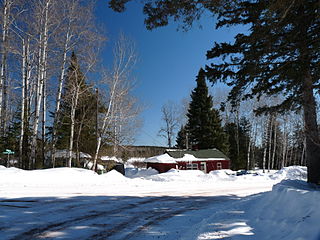
Morse is an unincorporated community located in the town of Gordon, Ashland County, Wisconsin, United States. Morse is located along the Bad River 7.5 miles (12.1 km) south-southeast of Mellen.

Shanagolden is an unincorporated community located in the town of Shanagolden, Ashland County, Wisconsin, United States. Shanagolden is located on the East Fork Chippewa River 10 miles (16 km) northwest of Butternut.
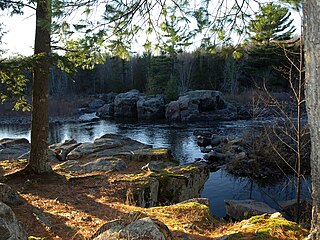
Grandfather Falls is the highest waterfall on the Wisconsin River. The total drop is 89 feet, spread out in a series of cascades over about one mile. The upper third of the falls and most of the flow, except in the spring, is diverted through a canal and a series of penstocks to feed hydroelectric generators. Grandfather Falls dam and power generating facility is owned and operated by Wisconsin Public Service Corporation.
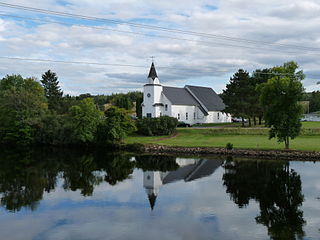
The Flambeau Mission Church is a historic church south of Ladysmith, Wisconsin, United States. The church was the first church in Rusk County, built just below the junction of the Chippewa and Flambeau Rivers in 1882 to serve the French and Indian community called Flambeau Farms. It was added to the National Register of Historic Places in 1979.
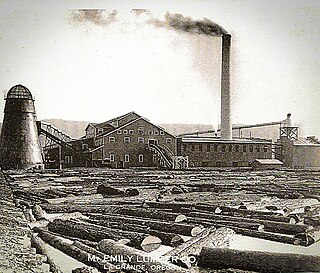
The Mount Emily Lumber Company operated in La Grande, Oregon from 1920 until 1956. After becoming a subsidiary of the Valsetz Lumber Company in 1955, the name was changed to Templeton Lumber Company. In 1960, the company was again sold and the name changed to Boise Cascade, La Grande.

Brooks-Scanlon Lumber Company was a lumber products company with large sawmills and significant land holdings in Minnesota, Florida, British Columbia, and Central Oregon. The company was formed in 1901 with its headquarters in Minneapolis, Minnesota. Beginning in 1915, its main lumber production facility was in Bend, Oregon. For many years, its Bend sawmill was one of the largest lumber producers in the world. In 1969, the company created Brooks Resources to broaden its business base beyond timber production. Brooks-Scanlon's Bend sawmill was closed in 1994. Today, Brooks Resources is the only vestige of the company that is still in business.

Edward Augustus Foster was a nineteenth century businessman and lumber tycoon known for helping to develop various lumber businesses.
















